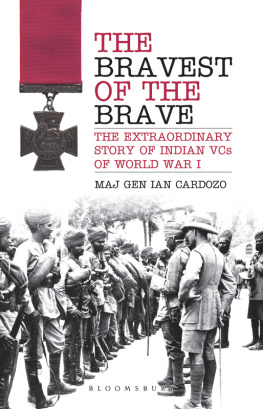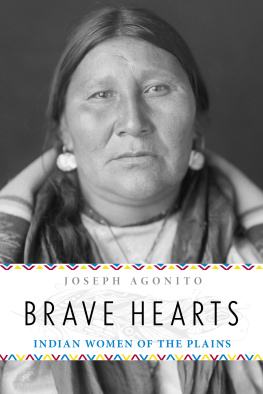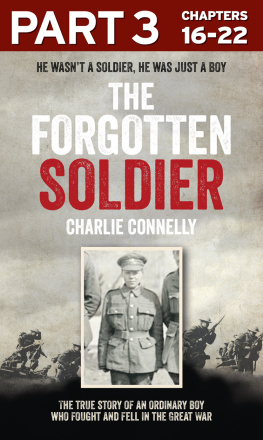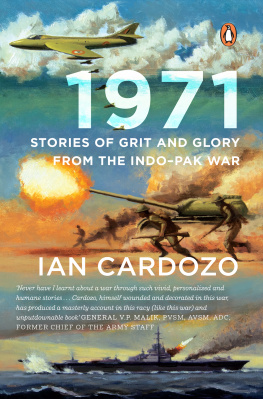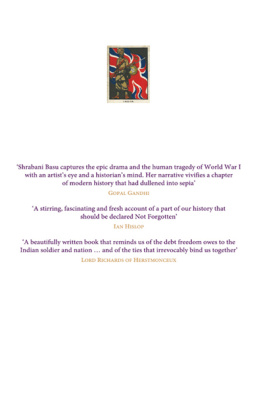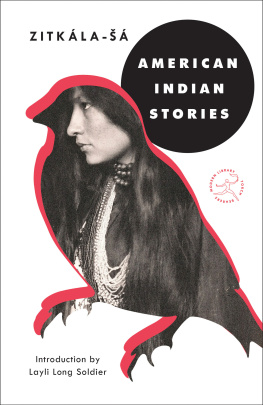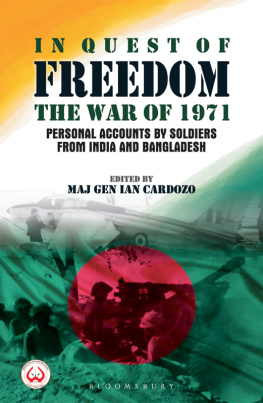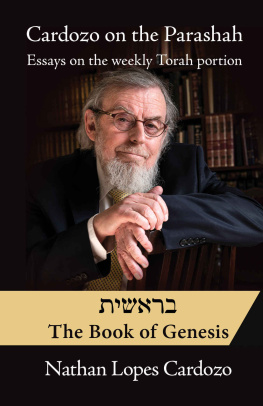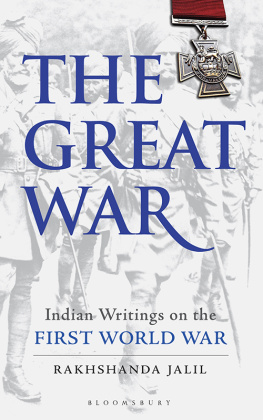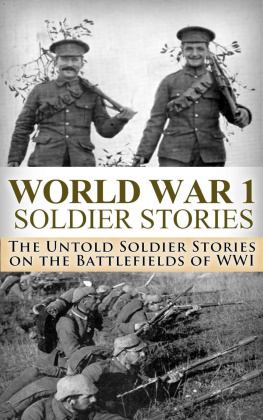Contents
Guide

The Bravest of the Brave
The Extraordinary
Story of Indian VCs of World War I
The Bravest of the Brave
The Extraordinary
Story of Indian VCs of World War I
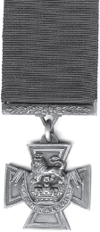
MAJOR GENERAL IAN CARDOZO, AVSM, SM



Maj Gen Ian Cardozo, 2016
First published, 2016
All rights reserved. No part of this publication may be reproduced or transmitted in any form or by any means, electronic or mechanical, including photocopying, recording, or any information storage or retrieval system, without prior permission in writing from the copyright holder.
No responsibility for loss caused to any individual or organization acting on or refraining from action as a result of the material in this publication can be accepted by Bloomsbury India or the author/editor.
BLOOMSBURY PUBLISHING INDIA PVT. LTD.
New Delhi London Oxford New York Sydney
E-ISBN: 978-93-86141-76-7
10 9 8 7 6 5 4 3 2 1
Published by Bloomsbury Publishing India Pvt. Ltd.
DDA Complex LSC, Building No. 4, 2nd Floor
Pocket 6 & 7, Sector C
Vasant Kunj, New Delhi 110070
The content of this book is the sole expression and opinion of its authors, and not of the publishers. The publishers in no manner is liable for any opinion or views expressed by the author. While best efforts have been made in preparing this book, the publishers makes no representations or warranties of any kind and assumes no liabilities of any kind with respect to the accuracy or completeness of the content and specifically disclaims any implied warranties of merchant ability or fitness of use of a particular purpose.
The publisher believes that the contents of this book do not violate any existing copyright/intellectual property of others in any manner whatsoever. However, in case any source has not been duly attributed, the publisher may be notified in writing for necessary action.

Dedicated to the soldiers of the Indian Army who fought with courage and commitment in World War I for the freedom of India and the world

War Memorials around the world dedicated to Indian soldiers who fell in World War I

Contents
4. Sepoy Khuda Dad Khan, VC
129th DCO Baluch Infantry
5. Darwan Singh Negi
1/39th Garhwal Rifles
6. Rifleman Gabbar Singh Negi, VC (Posthumous)
2/39th Garhwal Rifles
7. Jemadar (later Subedar) Mir Dast, VC, IOM
1/55th Cokes Rifles (FF), Attached to 57th Wildes Rifles (FF)
8. Kulbir Thapa
2nd Battalion the 3rd Gurkha Rifles
9. Sepoy Chatta Singh, VC
1/9th Bhopal Infantry
10. Lance Naik Lala (later Subedar) VC
41st Dogras
11. Naik Shahmad Khan VC
1/89th Punjabis
12. Lance Dafadar Gobind Singh VC
28th Light Cavalry attached to 2nd Lancers
13. Rifleman Karanbahadur Rana VC
2nd Battalion, 3rd Gurkha Rifles
14. Ressaidar Badlu Singh VC (Posthumous)
14th Murrays Jat Lancers, Attached 29th Lancers
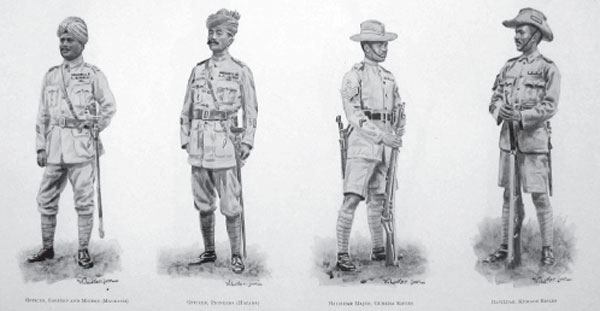
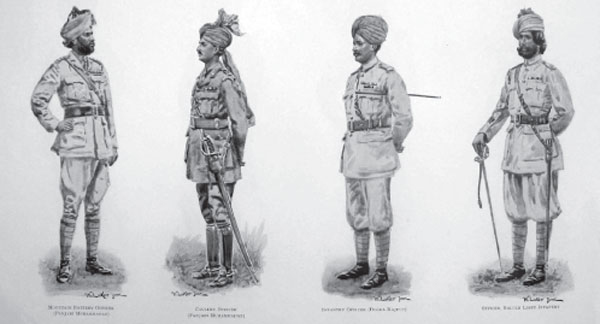

By the beginning of the twentieth century, the three armies of Bengal, Madras and Bombay were integrated into one Indian Army. It was equipped with old weapons and had no artillery. After the 1857 Uprising, the Governments both at London and in India wanted their British Army in India to have an edge in weaponry over the Indian Army for obvious reasons. However, they kept the Indian Army well equipped to fight the tribesmen on the North West Frontier and to fight colonial wars for the British Empire in different countries of Asia and Africa.
War clouds were gathering in Europe in the early twentieth century. Lord Kitchener took over as C-in-C of the Indian Army in 1902. He reorganized the Indian Army for a role against the rising power of Germany. In 1914, two divisions of the Indian Army were rushed to the winter cold in France. Defying all odds, their performance in battle was excellent, earning much praise. As the war progressed, over one million Indian troops were engaged in fighting for the Empire in different countries of Europe, Asia and Africa.
Till 1911, the Indian soldier was not eligible for the highest gallantry award of the Victoria Cross. However, British officers and British NCOs serving with Indian units were eligible for the VC. Lord Roberts earned his Victoria Cross after the siege of Kanpur in 1858. The highest gallantry award available for an Indian soldier was the Indian Order of Merit. This was the equivalent of the VC for them. It is remarkable that Subedar Kishenbir Nagarkoti of 1/5th RGR (FF), later 1/5th Gorkha Rifles, won the Indian Order of Merit, four times. As a special case, the fourth Bar was made in gold and presented to him with the approval of the British sovereign. This was a unique feat which has never been repeated. Had Indians been eligible for the VC at that time, this would have meant his getting the VC four times. As far as I know, it is very seldom for anyone, then or now, to be given even one Bar to the VC. However, I believe that a British Group Captain of the Royal Air Force serving in South East Asia Command during the Second World War had a VC and Bar. He had taken part in the Battle of Britain in which the average life of a pilot was a mere twenty-one hours. He had been with our Corps Headquarters in Indonesia in 1946.
The British Government decided to make Indian soldiers eligible for the VC in 1911. This was perhaps because a World War was looming on the horizon and the Indian Army would have to play an important role.
General Cardozo has done commendable research on the history of the Victoria Cross. He has written a brief overview of the course of military operations in the First World War, providing a good backdrop to highlight the splendid contribution made by the Indian Army in that war. There are some rare photographs of events and battle scenes in this book. The citations of the 21 Indians who earned this highest gallantry award for the bravest of the brave soldiers, provides authenticity to the book. The incredible saga of bravery of the Indian soldier made his countrymen proud and established the fame of the Indian Army in the world.

